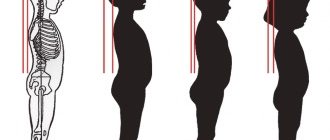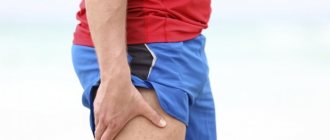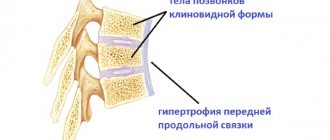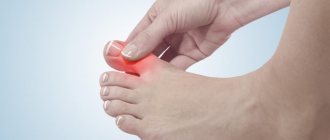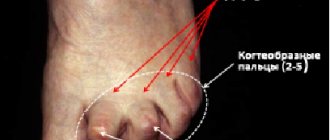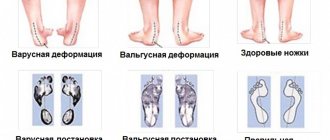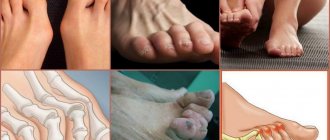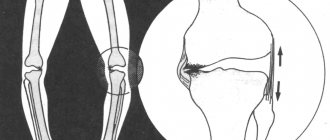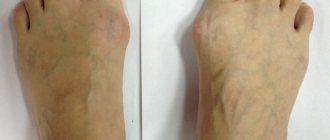A “bunion” on the foot and the inextricably linked deviation of the big toe occurs in almost 25% of the adult population. The medical name for this pathology is “Hallux valgus,” which translates as “deviated thumb.” Any deformation of the foot seriously affects all overlying parts: ankle, knee and hip joints, spine. “Bones” on the feet can manifest as fatigue, pain in the legs, an increase in the size of the foot, destruction of shoes, skin, joint and aesthetic problems.
Causes
The immediate cause of the appearance of bunions at the base of the big toe is transverse flatfoot. An additional mechanism of overload is pronation - “rolling” the foot inward. A sharp increase in body weight, standing work and wearing high-heeled shoes overstrain the tendons and muscles of the foot. Female sex hormones and glucocorticoids, which reduce the strength of ligaments, also have a certain effect. Normally, the arched arch in the forefoot gradually flattens and loses its normal shape.
A decrease in the height of the transverse arch leads to overload of the joints and divergence of the metatarsal bones, which “pulls” the fingers along with them. There is destruction and thickening of the joints, resorption of the shock-absorbing fat pad, compression of blood vessels and nerves.
Night correctors
Nighttime corrective devices include:
- Night corrector bandage;
- Night tire.
The bandage is used only at night, so its effect is much stronger than that of daytime silicone correctors; by tensioning the Velcro strap, you can adjust the deviation of the sore finger, i.e., the more powerfully the strap is tightened, the more the finger deviates. This device can be used while sitting at rest, because... The design will not allow you to step on your foot. Splints used at night are softer, they are made almost entirely of fabric, but in the area of the bone there is a special plate that allows the thumb to be in a straight position and prevents it from bending. The strap can also be used to adjust the inclination of the finger.
Symptoms and complications
The first symptoms of incipient flat feet are pain in the feet and leg fatigue. At the same time, there is no visible deformation yet, and the body is still trying to maintain the correct position of the bones. The body sends “signals for help” in order to somehow relieve the load from painful feet.
It is this initial, embryonic stage that is the most favorable time for effective treatment. Even minimal correction shows good results and can finally stop the development of flat feet. Ignoring the first symptoms leads to the development of pronounced transverse flatfoot with its typical symptoms:
- foot expansion,
- deviation of the 1st and 5th fingers,
- growth of the “bone” at the base of the 1st finger,
- the appearance of painful corns under the fingers,
- hammertoe curvature of the 2nd-4th fingers,
- inflammation, pain of the metatarsophalangeal joints,
- arthrosis of the foot joints,
- chronic pain and fatigue of the feet, etc.
It is the “bone” that causes the most problems. A large bone growth destroys even the most durable shoes, causing abrasions, redness and inflammation of the skin. A serious cosmetic defect is also obvious, which is often the reason for a visit to the doctor.
Rubbing your skin against the surface of your shoes can lead to non-healing wounds, infection and severe pain. The deviation of the toe sometimes reaches such magnitudes that it forces the 2nd or 3rd toe to be amputated in order to continue using shoes.
Modern solutions for treatment and prevention
Concerns about your health should be a reason to visit a doctor. The only way to remove an existing “bone” is surgical treatment. There are more than 130 types of operations for transverse flatfoot, and each of them has its own advantages and disadvantages. Like any other intervention, such procedures are characterized by certain complications, unsatisfactory or incomplete results. You can do without surgery if you start the prevention and treatment of flat feet in a timely manner.
Since the immediate cause of the “bunion” is a decrease in the height of the arch and pronation of its middle section, unloading the foot is most effective. Orthopedic insoles can support the transverse arch, reduce the load and normalize the position of the feet. The most noticeable results are achievable when making individual orthosoles. Elements selected and formed for each foot (instep support, braces, bolsters, heel pads) allow you to carefully and effectively influence overload zones.
Daytime correctors
They are used not only in casual shoes, but also in high-heeled shoes. They are made of silicone or fabric materials, they are inserts for the interdigital space with an overlay on the bone or on the front of the foot. They protect the joint of the problematic toe and part of the foot from excess pressure and friction, thereby reducing pain when walking. The disadvantages of these products include the fact that the angle of deviation of the first finger remains unchanged, since there is a soft silicone liner between it and the second finger, and it only moves the fingers away from each other a certain distance.
How to treat hallux valgus?
The insoles have a massage effect, improve venous outflow, and have a positive effect on support, balance and shock absorption. When made in the initial stage of flat feet, orthopedic insoles can prevent the appearance of bunions and corns. If changes have already appeared, the insole will stop their further growth. When understanding the cause of the disease, it is important to influence individual symptoms.
Such useful devices as:
- interdigital septa,
- callus pads and gel protectors,
- gel correctors and metatarsal inserts,
- night and day finger splints.
An integrated approach may include wearing comfortable orthopedic shoes, using massage devices, correcting posture and joint mobility. Take into account the axiom: the earlier treatment begins, the more effective it will be. It is important to pay attention to even minimal pain and deformation, since without correction the symptoms will only worsen. It is also extremely important to wear orthotics. They will ensure the correct physiological position of the feet during walking and evenly distribute the load on the feet.
Author of the article: Eduard Svitich - orthopedic traumatologist
Treatment
Treatment is carried out mainly in the following ways:
- orthopedic insoles;
- physiotherapy;
- operation (if the situation is advanced).
A specialist will help you choose the right insoles that will help avoid flat feet and correctly distribute the load, as a result of which blood circulation will gradually return to normal. Physical education is also designed to relieve stress and stimulate blood circulation.
If necessary, there is no need to be afraid of surgery. It is not complicated, but requires careful treatment of the foot in the next 3-4 weeks after the intervention. Full recovery comes in 2-3 months. It is important not to delay, because in particularly advanced cases, some pain when walking may remain even after surgery.
Types and uses of hallux valgus bandage
In orthopedic salons and pharmacies there are many different types of products that are designed to fix the foot in the correct position in case of hallux valgus. All devices redistribute the load on the forefoot, reducing pressure on the metatarsal bone. Some braces also prevent transverse flat feet.
Silicone splint
This type of corrector is the most inexpensive and popular - an example is the Valgus Plus splint. Such bandages are made of soft material, they are worn between the first and second toes; the protruding bone will be covered with a silicone “petal”. Usually the products are sold two per pack, are invisible even in open shoes, do not rub, and are very comfortable.
The principle of operation is to stop rubbing the bump on the foot and redistribute the load. It makes sense to use a silicone splint only as a symptomatic remedy or to prevent valgus. A proofreader cannot completely eliminate the problem. According to doctors, the product does not provide a true therapeutic effect; straightening of the damaged joint does not occur.
Bone retainer on hinges
An articulated valgus splint is a relatively soft frame for fastening to the foot and crooked toe using special devices. The splint has Velcro that will help fix the finger in a physiological position and create an additional shock-absorbing layer. The articulated brace has an elastic material over the metatarsal area, which is attached to the leg with straps. The design includes a lining that reduces the pressure of the shoe on the foot, and a plastic hinge. The latter will fix the leg in the desired position.
Articulated braces are worn on the legs every day before walking or standing. They do not move even with fast movement and do not interfere with wearing shoes. Gradually, the first, second and third fingers, which are most often displaced, return to their natural position. In severe cases, it is recommended to leave the corrector on the leg even overnight to ensure continuous treatment.
Night bandage
During the daytime, it is recommended to use braces that are not too rigid to allow the leg to move when walking. But in some cases, there is no sufficient therapeutic effect for valgus. Then doctors advise stabilizing the condition of the limb at night with the help of night bandages.
Such devices look like rigid spacers attached between the thumb and the rest of the fingers. The design is securely attached to the foot and toes, so it does not fall off during sleep. Usually the effect of use is excellent. At home, some devices can be worn even during the day (without shoes), but others are only suitable outside of human movement. After several months of nightly wear, the finger is guaranteed to return to its original position.
Hallufix thumb fixator
The hallux valgus splint Hallufix was developed in Germany to get rid of foot and toe deformation problems. The product can be worn during the day and at night, the bandage is suitable for all types of shoes, is compact, does not rub or damage the skin. Usually, wearing the device for 3 months is enough to eliminate valgus. It is best to wear the splint for up to 3 hours during the day and all night for optimal results.
After putting on the product, the leg is fixed in the correct position and remains secured while walking. Protruding bones will be protected from the appearance of painful calluses, and their size will gradually decrease. The risk of developing complications of valgus is noticeably reduced (we are talking about arthrosis and bursitis). The only downside is the price of the device - about 4.5 thousand rubles, and after a couple of months you will have to change the set of soft inserts (its price is about 2 thousand rubles).
Valgus splint Hav Splint
If a person suffers from hallux valgus, experts recommend using the Hav Splint night splint. For many patients, the device helped avoid surgery. The bandage immobilizes the leg, preventing the foot and toes from deviating from their natural position, and is securely attached to the leg.
Corrector actions:
- correction of thumb position;
- relief from pain;
- reducing the load on the foot;
- restoration of the normal angle of the transverse arch of the foot.
The tire is universal, suitable for any foot, every size. The fastener straps are strong, but do not squeeze the skin and do not cause inconvenience. After putting on the retainer, you must immediately go to bed and cannot walk. In the first days, slight discomfort and unusual sensations are possible, which quickly pass.
Valgus fixation Valufix
The Valufix foot corrector is a valgus articulated splint that was developed taking into account the requirements of orthopedists. Wearing a corset will help relieve pain when walking, which inevitably occurs when you have foot valgus.
The set includes:
- durable plastic hinge;
- removable side pads;
- bandages for the metatarsus and big toe;
- porous pad for protecting the metatarsus in the shape of a drop.
The orthosis should be put on clean skin, the fasteners should be sealed, a pad should be placed under the foot, and then you can walk without restrictions.
A comprehensive approach is important
It is important to take a comprehensive approach when treating hallux valgus. This means combining the use of a silicone product during the day to improve walking comfort with therapeutic products such as a bandage or hallux valgus splint, which can be used to restore the correct shape of the foot. A separate device is a stretching simulator. With its help, you can train your feet and first toes by performing various exercises. This simulator will add efficiency to treatment.
Orthopedic products for bunion correction in the online store Stelki.ru
Indications and contraindications
For any deformity, especially valgus, it is necessary to use special orthopedic devices, but splints should be selected solely on the recommendation of a doctor.
Indications for the use of these devices are:
- the appearance of a bone;
- joint displacement;
- postoperative period;
- the presence of valgus flatfoot;
- problems with bone and musculoskeletal systems;
- recovery from injuries, fractures and wounds, and more.
Contraindications include:
- swelling of the extremities and pronounced inflammatory processes;
- bleeding stitches and poor scarring;
- skin diseases, especially if they are pronounced in the joint area;
- rheumatism, gout;
- diabetes;
- hypertension;
- arthritis;
- problems with lymph flow and blood circulation.
Hallux valgus or “bunion on the big toe”
Each orthopedic device has strengths and weaknesses. Thus, a rigid valgus splint, that is, a night bandage, is used in 98% of cases in the postoperative period or in the treatment of the third degree of curvature. An articulated thumb straightening splint is suitable for stage 2 and 3 treatment, while silicone devices are only suitable for stage 1.
Bandage selection criteria
Typically, wearing a brace is considered effective if one lasts at least 6 months. To treat two legs, you should purchase two products, but they may be different depending on the problems you have. You should only buy a product that has been selected by a specialist - otherwise you can harm the ankle joint. The degree of hallux valgus deformity, from first to third, severe, must be taken into account.
When purchasing, you should pay attention to the following tips:
- There are correctors that differ depending on the leg (right or left), and there are universal tires available.
- For preventive purposes, gel or silicone products are usually recommended, for emergency treatment - night bandages, after surgery - hinged correctors.
- If you tend to flatten the transverse arch of the foot, you should choose models with a special pad.
- Products with the ability to adjust will adapt to the changing parameters of the foot. It is better to purchase such a corrector than to then change it as you recover.
- At the very initial stage of hallux valgus, soft correctors are usually well suited; later, harder ones are purchased. Gradually it is necessary to increase the degree of tension of the product to reduce the deviation of the finger, eventually bringing it to normal.
Combined correctors
Another type of product for the treatment of hallux valgus is a combination product - a hallux valgus joint splint. It can be used during sleep, when doing household chores, when you go for a walk in ordinary, fairly wide or sports shoes. It contains a metal hinge in the area of the thumb bone, with its help the tire bends while walking and does not create inconvenience. The angle of deviation of the problem finger depends on the degree of tension of the strap. This tire also has adjustment for foot volume.
What it is and properties
A hallux valgus splint is an orthopedic accessory that is used to correct foot deformities in the big toe area. It is fixed on the foot, covers the sore joint and toe, correcting its direction. Designed to correct the position of the bunion in the early stages of the disease and reduce pain during movement. In addition, it can be used to prevent valgus when a woman walks in heels for a long time. Additionally, for a better effect while wearing such a splint, the doctor may recommend smearing the affected joint with a special cream.
It is important to choose the right fixator, otherwise it can harm the joint.

